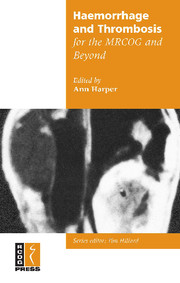Book contents
- Frontmatter
- Contents
- About the authors
- Abbreviations
- Preface
- 1 The coagulation system in pregnancy
- 2 Pregnancy in women with inherited bleeding disorders
- 3 Maternal and fetal thrombocytopenia
- 4 Massive obstetric haemorrhage
- 5 Disseminated intravascular coagulation
- 6 Gynaecological problems in women with bleeding disorders
- 7 Venous thromboembolism in obstetrics and gynaecology
- 8 Genetic thrombophilias and antiphospholipid antibodies
- Index
3 - Maternal and fetal thrombocytopenia
Published online by Cambridge University Press: 05 October 2014
- Frontmatter
- Contents
- About the authors
- Abbreviations
- Preface
- 1 The coagulation system in pregnancy
- 2 Pregnancy in women with inherited bleeding disorders
- 3 Maternal and fetal thrombocytopenia
- 4 Massive obstetric haemorrhage
- 5 Disseminated intravascular coagulation
- 6 Gynaecological problems in women with bleeding disorders
- 7 Venous thromboembolism in obstetrics and gynaecology
- 8 Genetic thrombophilias and antiphospholipid antibodies
- Index
Summary
Thrombocytopenia in the mother and fetus is a common problem. This chapter reviews its causes, clinical significance, investigation and management.
The platelet count in an uncomplicated pregnancy
The maternal platelet count tends to decrease by about 10% during pregnancy with the fall being most pronounced in the last trimester.
Maternal thrombocytopenia
The overall incidence of maternal thrombocytopenia (platelet count <150 × 109/l) is 6–7%. Incidental thrombocytopenia of pregnancy (or benign gestational thrombocytopenia) is the most frequent cause of maternal thrombocytopenia (74%), followed by hypertensive disorders of pregnancy (21%) and immune causes (4%). Less common causes include thrombotic microangiopathies, such as thrombotic thrombocytopenic purpura and haemolytic uraemic syndrome, and bone marrow failure due to a primary haematological disorder.
Incidental thrombocytopenia of pregnancy
There is typically mild thrombocytopenia with a platelet count in the range 70–150 χ 109/l. It starts in the second trimester, is most marked at the time of delivery, and is diagnosed by excluding other causes. It is probably a more pronounced form of the ‘physiological’ fall in the platelet count in uncomplicated pregnancies described above. The pathogenesis is not well understood, but is probably due to the combined effects of haemodilution and increased nonimmune platelet destruction.
There is no clinical impact on the mother or fetus. The maternal platelet count returns to normal within 6 weeks of delivery. Management merely involves observing the platelet count, and avoiding any unnecessary intervention.
Hypertensive disorders of pregnancy
Hypertensive disease in pregnancy remains one of the leading causes of direct maternal mortality.
Keywords
- Type
- Chapter
- Information
- Haemorrhage and Thrombosis for the MRCOG and Beyond , pp. 27 - 41Publisher: Cambridge University PressPrint publication year: 2005



